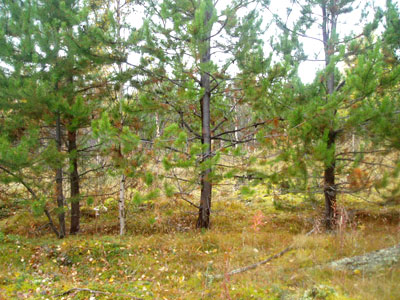
EXPERIMENTAL PLANTATIONS OF FORESTRY-VALUABLE AND TECHNICAL CULTURES
In connection with increasing deficiency of raw materials in some industrial regions the NRIF Dendrological Garden carries out research on opportunities of different introduced plants usage for solving some of these problems. In particular, one of the ways of providing of timber processing enterprises of the region with timber can be plantation cultivation of fast-growing wooden species.
Studies in this direction have being conducted since 1979. As a result there was accumulated a great experience in establishment of plantations in different regions of the European North (Arkhangelsk and Vologda regions, Komi Republic). The following species were involved in the experiment: Pinus contorta var. latifolia, Pinus peuce, Pinus banksiana, Pinus strobes; Larix sibirica, Larix gmelinii, Larix kurilensis; Picea mariana, Picea abies, Picea pungens cv. glauca, ajanensis; Abies sachalinensis, Abies homolepis; Pseudotsuga menziesii; Populus newesis, Populus laurifolia, Populus trichocarpa, Populus baicalensis, and others. Local species have been planted as control if there was an opportunity. Total area of experimental plantations was more than 50 ha.
According to the results of experiments on the European North, Pinus contorta var. latifolia and Populus newesis were recognized as the most promising.
Pinus contorta var. latifolia S. Wats naturally grows in North America. It is considered one of the most promising species for fast growth of pulpwood in countries with temperate climate.
Conducted studies confirmed fast growth of this species in young age. Thus, at the age of 15-20 years it gets ahead of Pinus sylvestris 1,3-1,4 times in height, 1,6-1,9 times in diameter, and 2,3 times in stem volume. By the age of 40-50 years it accumulates 250-300 m³/ha of low resin timber. Pinus contorta var. latifolia reaches its maturity 20-30 years earlier than Pinus sylvestris and 40-60 years earlier than Picea abies.
Timber of this pine can be used for sulfate and sulfite pulp cooking. Experimental pulp cooking showed that sorted mass output had amounted 45,6 %.

Populus newesis Bogd. At the age of 18 years its height reaches 15,6 m and diameter (b.h.) – 15,2 m. Conducted studies show that the poplar in this age 3 times exceeds aspen in seasonal stem increment. And according to calculations made on the base of test trees at the age of 20 years with planting density of 1600 plants/ha, total reserve of stemwood can reach 365 m³/ha and current increment – 55 m³/ha per year.
Resulting laboratory pulp cooking, cellulose output from poplar timber amounted about 60%.
For wider use of lodgepole pine in the condition of the European North, a technology of its seedling growing in greenhouses with polyethylene cover was developed. This technology contains agrotechnology of seedlings cultivation, rates of mineral fertilizers application and required preventive attendance. Also the most effective methods of poplar planting material growing in the regional conditions were defined.
With the aim of efficient use of the Northern resources and particularly large land areas not suitable for agricultural use, the genofond of local and some introduced species of willows was studied for tannins content. It was found that tannin content in the bark of the northern willows can be compared with the southern species, and it gives ground to include the northern region into the zone of industrial willow cultivation. Plantation of tannin willows was laid to asses economic efficiency and possibilities of selection work.
Resulting laboratory pulp cooking, cellulose output from poplar timber amounted about 60%.
For wider use of lodgepole pine in the condition of the European North, a technology of its seedling growing in greenhouses with polyethylene cover was developed. This technology contains agrotechnology of seedlings cultivation, rates of mineral fertilizers application and required preventive attendance. Also the most effective methods of poplar planting material growing in the regional conditions were defined.
With the aim of efficient use of the Northern resources and particularly large land areas not suitable for agricultural use, the genofond of local and some introduced species of willows was studied for tannins content. It was found that tannin content in the bark of the northern willows can be compared with the southern species, and it gives ground to include the northern region into the zone of industrial willow cultivation. Plantation of tannin willows was laid to asses economic efficiency and possibilities of selection work.

